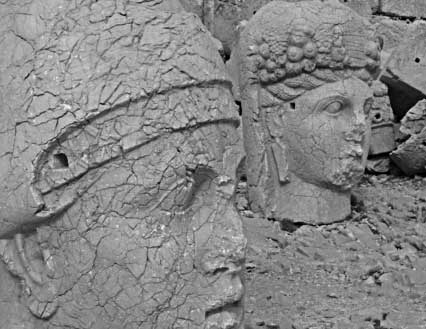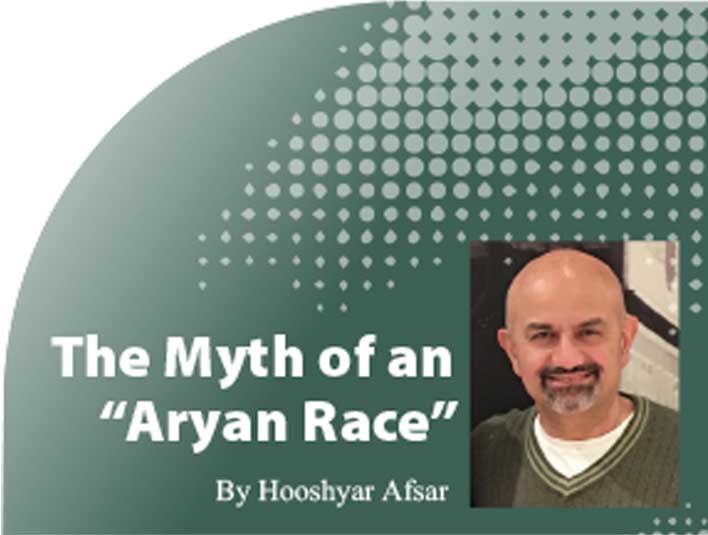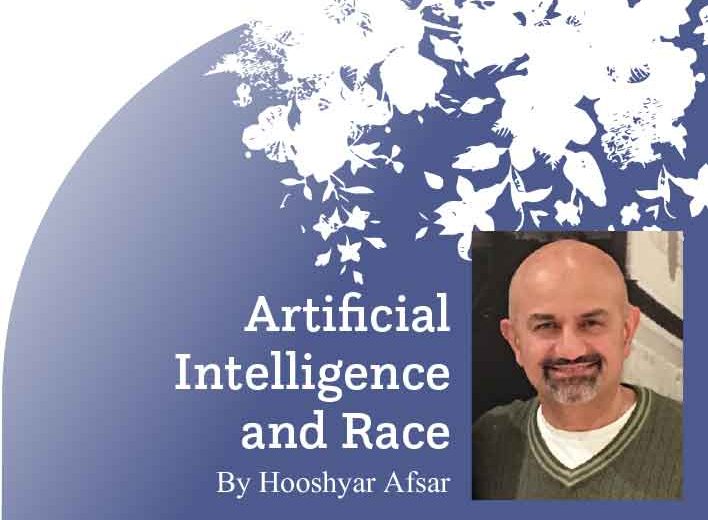The Myth of an “Aryan Race”
PART 1
By Hooshyar Afsar
Introduction
While many authors have written about the Aryan myth, the goal of this two-part article is to focus on the Persianized version “Aryan Race.” In Persian, it is called the nezhād-e āriyāyi and it has its own implications in the history of Iran for the past 100 years.

With the birth of the Woman, Life, Freedom movement in September 2022, there are again rumblings of Iranians being the original Aryans (in Persian, the term “āriyāyi” is used). Many Iranians are still influenced by the historical narrative disseminated during the Pahlavi era, while a second, much smaller group are knowingly supporting the racist ideology of “Aryans” in Europe and North America. More specifically, there was one instance of a racist chant in the northeast Iranian city of Mashhad saying: “We are Aryans, we don’t worship Arabs.’’ [1] This chant was also heard by a few during the October 2022 Berlin 80,000+-attended demonstration in support of the WLF movement and it was quickly stopped by the organizers. There is also a report from Tehran’s Evin prison about a group of far right monarchist prisoners who insist on their “Aryan” roots and are motivated by far right and openly fascist electoral victories in Europe. [2]
In this first part, we shall take a general look at “race” from historical and scientific viewpoints. In the second part, to be published in the next edition of Peyk, we will specifically analyze the historical roots of the terms “Aryans” and “Aryanism” in Europe and “Aryan race” in Iran.
What is “race”?
First, we should ask what is the most effective methodology for starting a discussion about “race.” While not perfect, the scientific method has the highest efficacy since it is based on data, experimentation, and observation. The question is whether dividing the human species based on “race” has any scientific or biological validity. The answer to that question is negative.
While many of the biologists and anthropologists of the eighteenth century and thinkers of the the “Age of Enlightenment” believed in dividing human species into hierarchies with different levels of intelligence, work ethic, artistic abilities, leadership, and so on, the completion of the human genome project in the year 2000 fully demonstrated that all human beings share over 99.9% of their DNA genetic code. Since the year 2000, all efforts to find a “race” gene have been unsuccessful.
One would then ask: if “race” doesn’t have any scientific basis, then why do human beings have clear and identifiable differences in observable characteristics such as color of skin, thickness and kind of hair, shapes of nose and lips, etc.? Aren’t these differences biological and, hence, scientific? The answer is that while science explains these differences, they are not adequately significant to divide the whole species into a hierarchy of intelligence, work ethic, and other traits. Each species has variations within itself; these differences are known as clinal—”[d]erived from the Greek word clinein for slope, cline defines gradual change in a trait over a geographical space such as skin color.” [3] Clines are often cited to be the result of two opposing drivers: selection and gene flow (also known as migration). Selection causes adaptation to the local environment, resulting in different genotypes or phenotypes being favored in different environments. Meanwhile, gene flow has a homogenizing effect on populations. What this means in the human species is that adaptation to the local environment—including temperature and angle of sunshine, plus gene flow that is caused by migration and reproduction—has caused variations including skin color, thickness of lips, shape of nose, and texture of hair. So what is the mechanism for the human body to realize these variations?
Variations in the human species are expressed via a group of pigments called melanin. There are three kinds of melanin that affect the color of human skin, eyes, lips, and hair. The main function of melanin is to protect the skin from the sun’s ultraviolet (UV) rays, which could cause cancer. As part of the clinal adaptation, human beings closer to the equator need more melanin to protect their skin and their eyes. [4]
The dominant scientific model of geographic origin and early migration of modern humans or homosapiens is called the “the recent African origin of modern humans.” In simple terms, while homosapiens developed in Africa between 300,000 and 200,000 years ago and while there is evidence of non-continuous migrations over 200,000 years ago, sustained migration to Asia happened between 50,000 to 70,000 years ago and to western and northern Europe about 40,000 years ago. [5] The darker skinned homosapiens went through clinal changes and their skin color changed for the lighter and their other appearance characteristics also went through the process of adaptation to new climates.
So, if dividing modern humans into various races is not scientific and the differences are due to clinal variations within the same species, then what is “race”? Social scientists agree that race is a social construct. [6] It was invented for social and political domination and economic gain in the early eighteenth century during the “Age of Enlightenment.” Therefore, race as a social construct is a rather historically new concept since it is only about three hundred years old.
While many biologists and anthropologists in the eighteenth century talked about dividing the human species into a racial hierarchy, two are the most prominent considering the impact of their work and how other enlightenment thinkers used their hierarchies and referred to their work. Carl Linnaeus was a Swedish biologist and is considered the father of taxonomy in natural sciences and Johann Friedrich Blumenbach was a German physiologist and anthropologist. Linnaeus’ hierarchy divided human beings into four categories, with west Europeans being at the top echelon and Africans being in the bottom fourth group. Linnaeus described the Europeans as active, acute, and adventurous, while describing the Africans as crafty, lazy, and careless. [7] Blumenbach, on the other hand, came up with five categories and put Europeans in the first category, Africans in the fourth, and Native Americans (indigenous people of North America) in the fifth. [8] While Blumenbach argued against “racial” differences and used examples to show that Africans could excel in arts and sciences, his categorization and emphasis that all races came from the white “Adam and Eve” was still used, perhaps in spite of his intention, to promote racism. In the same light, although Charles Darwin was against racism after the publication of his On the Origin of Species in 1859, a whole movement of “scientific racism” started that continued through most of the twentieth century and is now totally discredited in the worldwide scientific community.
One may ask: if Linnaeus was a scientist and his system of taxonomy is still in use to a great extent, why isn’t racial categorization scientific? One thing that makes the scientific method a rather effective tool is its self-corrective nature. The scientific method calls for differentiating a verifiable or acceptable scientific theory from a verified theory. In the case of Linnaeus, his hierarchy—which was based in part on subjective “traits” and gave Europeans the more superior traits—was not scientific and was even refuted by Blumenbach, who theorized that differences between his categories were due to geographic and climate conditions and attempted to stay away from traits, including intelligence. Later on, scientific understanding of the notion of clines at molecular and genetic levels confirmed Blumenbach’s suggestions and disproved those of Linnaeus. Along the same lines, the Human Genome project put an end to any scientific validity for the notion of “race” and dividing the human species based on supposed scientific differences. The additional advantage of the scientific method is that it also revises its own methodology as it moves forward. Both Linnaeus and Blumenbach and many other Enlightenment thinkers believed in a religious interpretation of how humans came about on Earth; hence Blumenbach’s emphasis that all humans are descendants of Adam and Eve. The scientific approach in today’s age has gone beyond such assumptions and interpretations.
However, the fact that the invention of “race” as a social construct does not have any scientific and biological basis doesn’t mean that it did not have colossal social and historical consequences.
What are the consequences of “race” as a social construct?
Regardless of the intentions of scientists, philosophers, sociologists, and historians from the eighteenth century onward, the events of the last 300 years—mostly in Europe, Africa, and the Americas—demonstrate beyond any reasonable doubt that the most prominent outcome of the invention of race as a social construct has been racism. In fact, race and racism have become social realities impacting the lives and livelihood of billions of people.
According to Professor Henry Louis Gates, Jr., of Harvard, using the Trans-Atlantic Slave Trade Database [9] for reference, 12.5 million men, women, and children were kidnapped and shipped in horrid conditions to the Americas from 1525 to 1866 and 1.8 million of them perished during the terrible voyage. [10] When the American Civil War broke out in 1861, there were 4 million enslaved people in the United States who were owned as property and were not recognized as citizens. Slavery in North America and confiscation of Native American land by the way of genocide of millions of the indigenous population were directly linked to the emergence and development of industrial capitalism, first in England and later in other parts of Europe, as elaborately analyzed by professor Sven Beckert in his 2015 book Empire of Cotton: A Global History. [11] The social and historical trauma imposed upon enslaved people, their descendants, and all people affected by racism has never been fully remedied in the United States. [12] In fact, systemic racial and social control in the United States mutated from slavery in the early centuries to the regime of Jim Crow segregation and lynching terror by the last decade of the nineteenth century and then to the mass incarceration of Black and Brown people starting in the 1970s. [13] The rise of white nationalism and four years of the Trump administration have only more recently demonstrated the deep roots of white supremacy and racism in the United States.
If “race” has no scientific basis, why does the U.S. Census Bureau continue to ask about racial categories in its questionnaires? According to its own explanation, the purpose is not to “define race biologically, anthropologically, or genetically”—“[l]ocal, state, tribal, and federal programs use these data, and they are critical factors in the basic research behind numerous policies, particularly for civil rights… and to monitor compliance with anti-discrimination laws, regulations, and policies.” [14] In other words, the Civil Rights movement and its more recent incarnation, Black Lives Matter, have imposed anti-discrimination policies upon the United States government that makes gathering data on the social realities of “race” a legal requirement.
So how did the idea of the “Aryan Race” come about, when exactly did it start, and when did it become part of the Iranian national narrative? Those are questions to be explored in the second part of this article, which will be continued in the next issue.
References and Notes
[1] Many Iranians identify the Islamic republic as “Arab” and with the Muslim Conquest of Persia in 654 AD.
[2] https://www.akhbar-rooz.com/190310/1401/11/03/
[3] Lieberman, Leonard, and Rodney C. Kirk. “What Should We Teach about the Concept of Race?” Anthropology & Education Quarterly 35, no. 1, pp. 137–45 (2004).
[4] https://www.ncbi.nlm.nih.gov/books/NBK459156/
[5] Liu H, Prugnolle F, Manica A, Balloux F. “A geographically explicit genetic model of worldwide human-settlement history,” American Journal of Human Genetics 79 pp. 230-237 (2006).
[6] Alexander, Michelle. The New Jim Crow: Mass Incarceration in the Age of Colorblindness. The New Press (2012).
[7] https://www.linnean.org/learning/who-was-linnaeus/linnaeus-and-race
[8] Blumenbach, Johann Friedrich. “De Generis Humani Varietate Native Liber” [On the Natural Varieties of Mankind] (1775). In The Anthropological Treatises of Johann Friedrich Blumenbach and the Inaugural Dissertation of John Hunter, ed. and trans. Thomas Bendyshe, 65–144. London: Logman, Green, Longman, Robers, & Green (1865).
[9] https://www.slavevoyages.org/voyage/database
[10] https://www.pbs.org/wnet/african-americans-many-rivers-to-cross/history/how-many-slaves-landed-in-the-us/
[11] Beckert, Sven. Empire of Cotton. Penguin Books, Harlow, England (2015).
[12] Kendi, Ibram X. Stamped From the Beginning: The Definitive History of Racist Ideas in America. Nation Books, New York, NY (2017).
[13] Alexander, Michelle. The New Jim Crow. Penguin Books, Harlow, England (2019).
[14] https://www.census.gov/acs/www/about/why-we-ask-each-question/race/

















